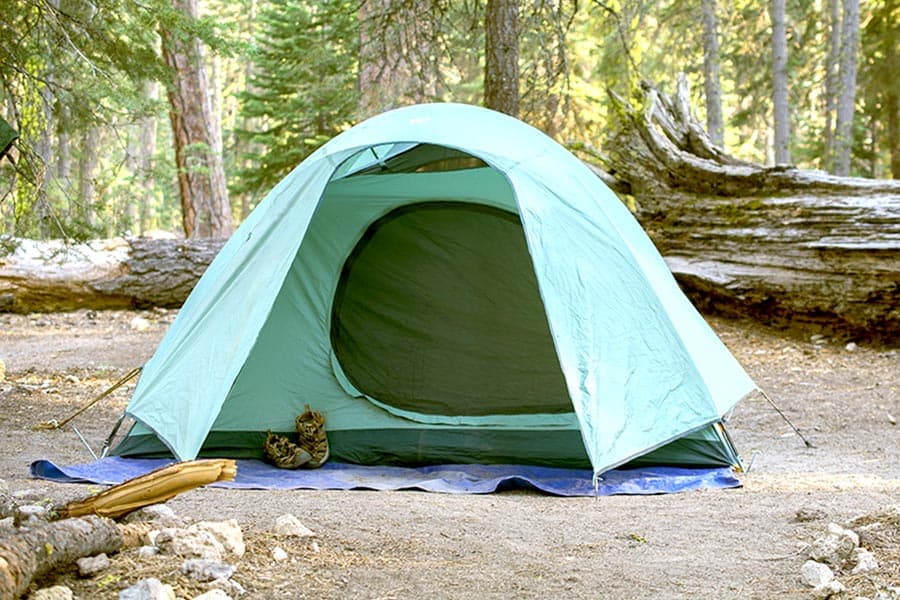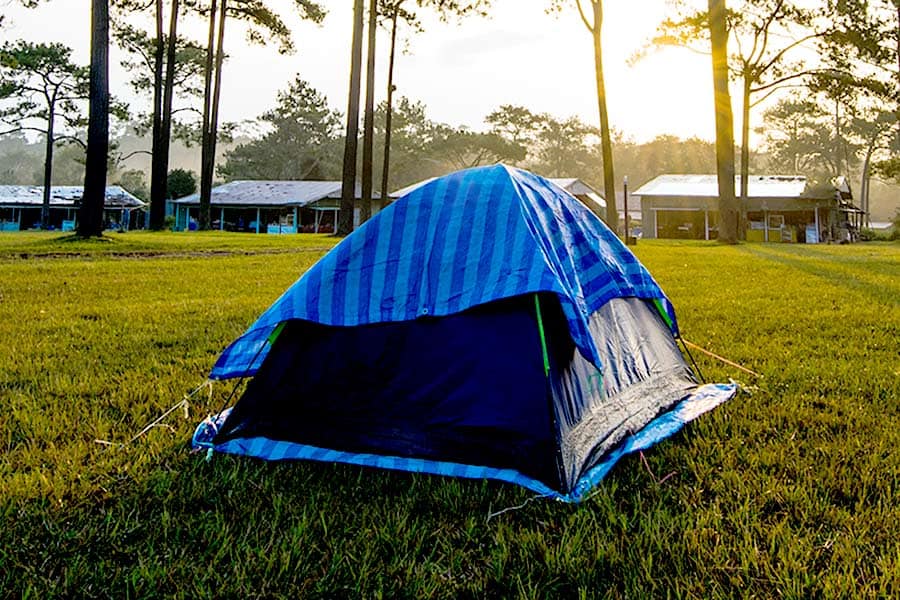
Ah, the great outdoors. As a person who enjoys nature, I can speak on the enjoyment of camping and getting out there to have fun while being outside. But when you’re out camping, you want to make sure you set yourself up for success to be protected from the elements. A way of accomplishing this is by using a footprint to protect the tent bottom from the ground below. But can you use a tarp as a tent footprint?
You CAN utilize a tarp as a tent footprint. Due to the tarps’ durability, we often use them to protect the tent’s exterior from the elements. Therefore, a tarp can be used under the tent to protect the bottom from the elements and ground debris as well.
In this post, you will read a few of the benefits of having a tarp under your tent, over your tent, and some other advantages that a tarp will give you while you are out camping. Any tips and tricks that you can learn to have a better camping experience are always a plus.
The size options of tarps actually make them an excellent choice for your tent footprint. Not only do they provide a durable foundation to set up your tent on, but you are creating a barrier where the bottom of your tent is protected, in turn protecting your investment.
Tarps come in many sizes; however, you probably won’t be able to find one the exact match for the size of the tent you own.
Using a Tarp as a Footprint
One of the best benefits of using a tarp for your footprint is that it can be utilized as a footprint, but you can always switch it back to a tarp if you need to. Say the weather isn’t going to be so great once you’ve arrived, the tarp would be utilized better by covering the top of your tent as a roof. It can be a good idea to have both a footprint and a tarp on-hand, just in case both need to be utilized. But if you forget the footprint and need to have something under your tent for protection, the tarp will serve you well.
It’s essential to set up your tarp footprint properly. An actual tent footprint that comes with your tent will always be the same size as the tent and won’t come out past the edges of your tent. Matching the size will not be the case with a tarp.
When using a tarp as a tent footprint, purchase a size that matches your tent size the closest. Most generally, the tarp will be a little bigger than your tent size. Therefore you will have to adjust the tarp accordingly. In most cases, you can fold the excess underneath, so the size matches, folding under keeps water from pooling in the tarp.
When you fold the tarp underneath that keeps the tarp intact so you can use it for other purposes later on. Some people cut the tarp to match the size of the tent. Cutting it can cause the tarp to start “fraying,” and also it removes the grommets, which makes the tarp useless for any other purpose.
Using your tarp as the footprint will require some additional planning, though, due to the larger size. What this means is that you will want to position your setup so that, if it does rain, the water isn’t going to accumulate on the tarp. Improper positioning can be a cause for some issues, especially if you end up with water pooling on the tarp.
Then, if the grade of the terrain is angled even slightly towards your tent, you’re going to get wet. So, position yourself correctly, test the grade of the ground and make sure that any moisture that gets onto the tarp will easily roll off the tarp footprint away from the tent. Easy as pie.
The polyethylene that tarps are typically made from actually provides increased durability as a footprint. An actual tent footprint is lightweight and easier to travel with if you’re backpacking. A tarp can be somewhat of a nuisance if your backpacking skills aren’t top-notch. They’re bulkier and are more substantial, so being a little more tactical when backpacking with a tarp is necessary.
But if you’re just out doing some camping, having a polyethylene tarp as your footprint means your tent will be less likely to rip or become damaged. Tarps are manufactured to be as durable as possible to hold up to the elements.
If you don’t already own a tarp, here are some options for you to consider.
Kotap makes a woven reversible polyethylene tarp that comes in a variety of sizes. It is water-resistant, UV protected, and has grommets that won’t rust. This tarp is made to stand up to the abuses you will put it through while camping.
If you want a heavier-duty tarp that can withstand a little more abuse, X-pose Safety makes one that is 10 mils thick. This tarp will be able to withstand all types of weather and will provide exceptional durability.
Another option comes from Whiteduck. This tarp is 16 mils thick, is available in many sizes, and is tearproof. It is UV protected to prevent it from breaking down from the sun’s rays and is made from polyethylene woven tightly to withstand the rigors of outdoor use.
Tents can become damaged from the rocks and other objects that are on the ground when you set up on top of them, a tarp will help protect your tent and save you money in the long run.
We also have a post about pitching a tent on gravel that will give you more information about dealing with this problem when you encounter it.
Protecting the Top of Your Tent

It is beneficial to touch on protecting the top of your tent as well. Protecting the bottom of your tent is recommended. So, protecting the top of your tent is going to be just as recommended, but for different reasons. Being out in the elements of nature is beautiful, refreshing, exciting, and fun.
But it’s also essential to give yourself the necessary protection, so you don’t end up in a miserable situation. Nothing says misery quite like being caught in an unprotected tent when a torrential downpour surprises you in the middle of the night.
The point is you should use both a footprint of some sort and a tarp to cover the exterior of your tent. Without it, you could get caught in a tricky situation. Having two tarps, one as your footprint and one as an actual tarp, is going to be your best bet.
You can protect the bottom of your tent, so no moisture from the ground is sneaking in. And you will also have your outer protection from additional elements like rain. But there are also some other benefits for protecting the exterior of your tent.
Other Posts of Interest
- Can You Get Sunburn Through A Tent?
- Hymer Aktiv Loft vs. Pleasure-Way Tofino: Which Is Right For You
- How to Choose the PERFECT Mattress for Camping in a Van
Tarps Keep You Dry
A tarp is going to keep you dry when it decides to rain out of nowhere. Nobody ever wants it to rain while camping. Furthermore, there may be absolutely no rain in the forecast for your entire expedition. But guess what? Mother nature has a plan of her own, and when she feels like bringing the rain, then you better be on the lookout. It happens. It’s all about preparing yourself for anything.
Tarps Keep You Warm
Warmth is sometimes an overlooked benefit of a tarp. Having a tarp over your tent is going to help keep the heat in. Especially when the sun goes down, and it tends to get a little chilly. Keep the heat inside your tent by adequately protecting it with a tarp. What’s better is the fact that having some sort of footprint under the tent is going to add to this benefit.
Tarps Help to Keep Your Gear Safe
Keeping gear safe is another point that may sometimes get overlooked. You have gear in your tent, sometimes expensive gear. You want to keep all of that stuff protected as well as you possibly can. Having a tarp over your tent is going to provide that added benefit, so you don’t have to worry about all your awesome gear getting screwed up by natural elements. It’s all about protection, my friends. And you are hoping for the best experience camping – while expecting anything to happen.
After reading this, you might be wondering if there is a better and easier way to camp? Maybe you are getting a little older, and the ground isn’t just as soft as it used to be. We have a post that discusses the benefits of van camping versus tenting, which gives you another option to consider.
To Conclude
Camping is awesome, at least for those of you who love the outdoors. And for those of you out there who haven’t gotten to experience the joy, we hope this post will provide some helpful information that is going to set you up for success.
As we’ve gone over, it’s best to protect ourselves when we’re spending time out in nature. Anything can occur, so having a game plan that keeps you safe and dry will serve you well.
Get yourself some big, durable tarps that are going to last for a long time, they won’t break the bank, and they provide the opportunity to be a footprint or a cover. Have fun out there and enjoy yourselves, be safe, and get out into the outdoors as mother nature intended.





